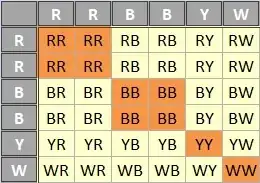This is from Sheldon Ross's book -
Two symmetric dice have both had two of their sides painted red, two painted black, one painted yellow, and the other painted white. When this pair of dice is rolled, what is the probability that both dice land with the same color face up?
Probability aside, I want to understand how to compute the number of events that both dice land with the same color face up.
I start with total number of combinations I can get by throwing these 2 dice. Suppose for reference, the dice are marked as 1 and 2, the first dice has the faces R11, R12, B11, B12, Y1 and W1 and the second has R21, R22, B21, B22, Y2 and W2. If I am performing this experiment, I would consider the red faces showing up as one outcome, i.e., if I get any of these 4 outcomes : (R11,R21), (R11,R22), (R12,R21) and (R12,R22), I will consider as a single outcome (R,R) because the dice are symmetric.
But the textbook takes all 4 Red outcomes as different and count as 4. I want to understand why is that? To an observer, the red colored sides will look exactly same, so shouldn't it be counted as one outcome?
Please explain if I have not understood it correctly.
